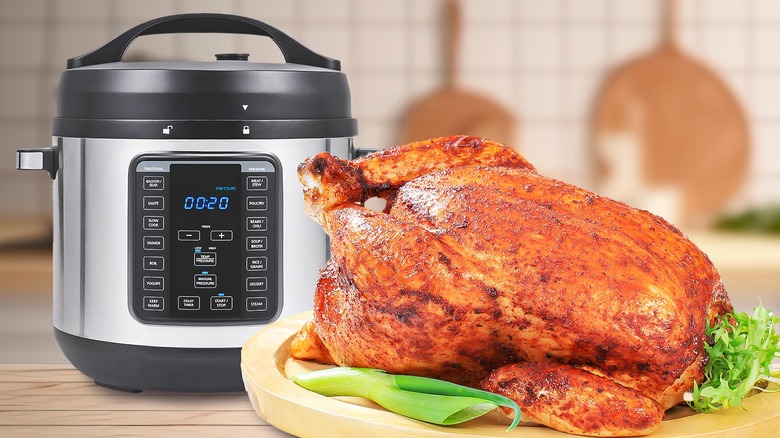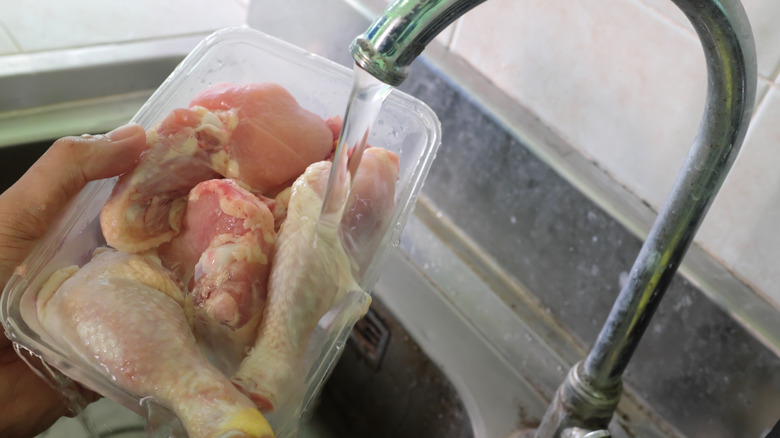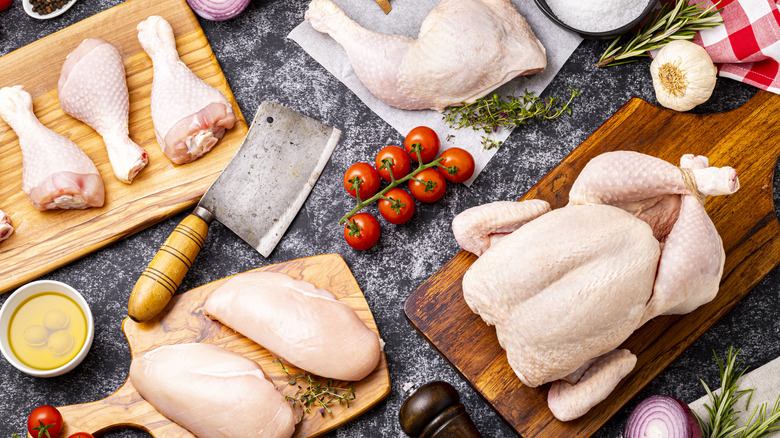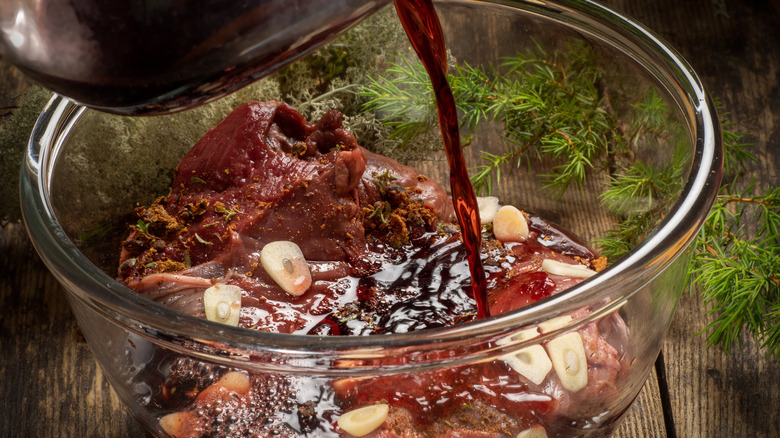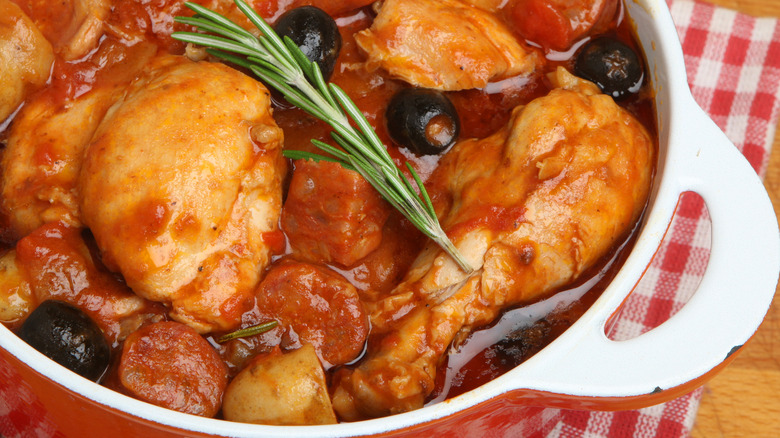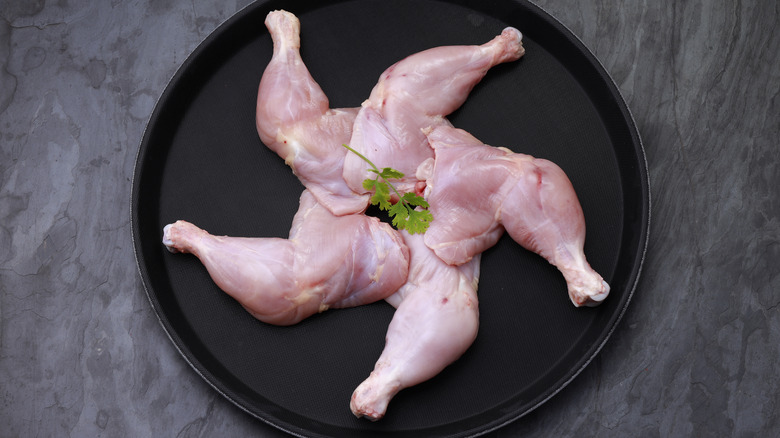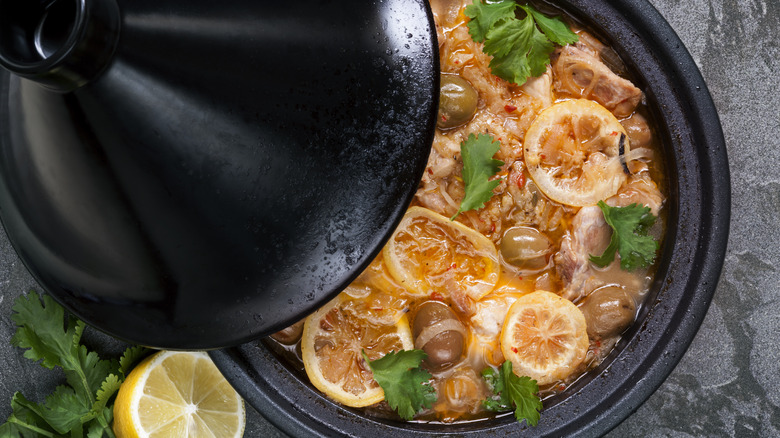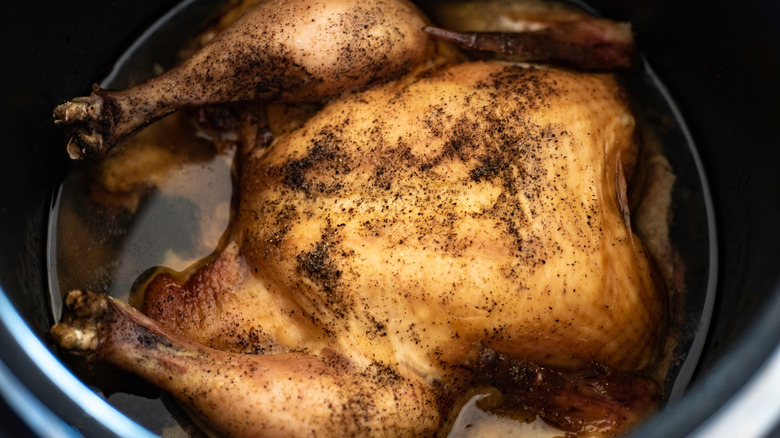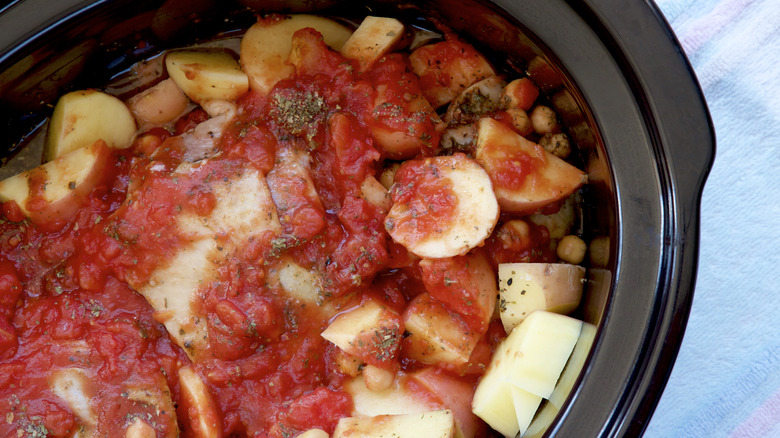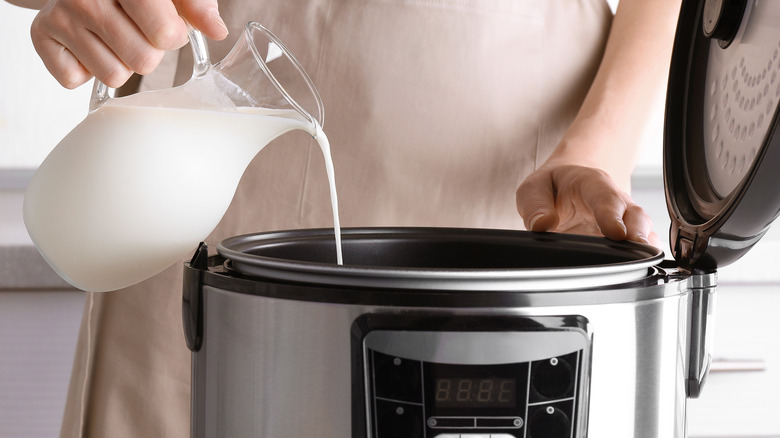12 Tips For Making Chicken In Your Slow Cooker
Ah, slow cookers: the holy grail of "set it and forget it" cooking appliances. And since there are literally countless ways to prepare chicken, it's every busy human's favorite protein. So naturally, chicken and slow cookers should go together like beans on toast (except chicken and slow cookers have a much more harmonious relationship). Of course, preparing a juicy, flavorful, and wholesome chicken meal in a slow cooker can turn sour if you aren't careful.
Yes, the ease of a slow cooker can be a bit deceiving to the untrained eye. The truth is that even the most basic meals can become dry, rubbery, and bland if prepared incorrectly in the slow cooker. From the vegetables you use to the exact cut of chicken, every step of the slow-cooking process is important if you want to be greeted by a perfectly delectable chicken when you lift your slow cooker's lid. Luckily, we've compiled a few simple slow-cooking tips so you can avoid a flavorless fate.
Thaw the chicken before you toss it into the pot
We've all been there: it's 7 p.m., you're bone-tired after a long day of work, and you come home to find that the chicken breast you'd planned on inhaling is still a block of ice in the freezer. You may think that the slow cooker is your best friend if you hate waiting for the chicken to thaw — just toss it into the hot cooker, right? Not so fast. If you don't thaw your chicken before adding it to your slow cooker, the time it takes to thaw in the pot may hurt your chicken's flavor — and could hurt you.
It's common knowledge that salmonella can thrive in raw chicken, and when improperly cooked, salmonella can find its way into you and your dinner guests. Putting a cut of frozen chicken into the slow cooker and expecting it to come out well-cooked just isn't safe because it will take longer to cook to its ideal internal temperature. That's why the U.S. Department of Agriculture recommends that you safely thaw your chicken before putting it into a slow cooker. Less importantly, thawing chicken in a slow cooker can lead to bland chicken, which is just gross!
The cut of chicken you use matters
You can use virtually any cut of chicken in a slow cooker and end up with a deliciously succulent dinner, but some cuts require more attention than others. Chicken thighs, such as those used in a hearty chicken cacciatore dish, and bone-in cuts are better for slow cooker meals because they contain rich dark meat that becomes juicy and flavorful under high temperatures. For the most part, you can chuck them and any other ingredients into the pot and walk away.
Lean chicken breasts, on the other hand, tend to cook away or lose flavor if not carefully watched in the pot. If you are going to use a chicken breast, shredding it, as this chicken and dumplings recipe suggests, could prevent it from drying out. Regardless of the cut you cook, of course, the "set it and forget it" mantra should be used loosely. It's always wise to keep an eye on how your chicken is cooking in a slow cooker, especially if you're trying out a new recipe.
Check your wine cabinet for unexpected flavors
Unexpected but delicious additions to your easy, down-home chicken meal can come from anywhere ... even a bottle of wine. Different meats call for different types of wine, especially if you're using wine as a marinade. If you want to add a slosh of your favorite wine to a chicken marinade, a good rule of thumb is to stick to the whites: a heady Bordeaux works better in beef and pasta dishes, and a dry pinot grigio or sauvignon blanc would pair well with a lighter chicken dish. And when it comes to slow cooker meals, the more moisture, the better — why shouldn't the moisture come from your favorite white wine?
Adding a dry vino, like pinot grigio, can help trap in some moisture, which is essential if your chicken runs the risk of drying out in a slow cooker. Plus, adding a dry white wine to your chicken marinade can add an acidic complexity to an otherwise straightforward chicken dinner. Keep in mind, however, that a little wine will go a long way. Since slow cookers only get so hot, alcohol doesn't burn away as it does in a pan. It would be wise for you to cook the alcohol down in a frying pan before adding it to your slow cooker.
Add sauce at the beginning of the process
A slow cooker's bread and butter is stews, soups, and sauces for a reason: the appliance wouldn't work without moisture. The closed lid ensures that excess steam is emitted from the cooking food, which goes a long way to keeping your food — especially your meat — succulent and savory. And since we all know how easy it is to watch a chicken meal go from tender and juicy to dry and bland, you should keep an eye on the liquid levels in your slow cooker. It's important for slow cookers to be either halfway or ¾ full of liquid so that your chicken is completely immersed and able to fully cook.
A good rule of thumb is to keep chicken covered by your sauce, stock, or broth throughout most of the cooking process. Adding the sauce at the beginning of the process won't only keep the chicken moist, but will help infuse it with all the other flavors swimming around in the pot. Of course, there are dangers when it comes to having too much liquid in your slow cooker. As anyone who has ever slurped a spoonful of watery, tasteless stew could tell you, it's an experience you should try to avoid. Thankfully, avoiding this flavorless fate is easy enough to do. Just don't overfill your slow cooker with liquids, and keep an eye on the ingredients you're using that could needlessly contribute to the liquid levels in your slow cooker. Canned tomatoes, zucchini, and broccoli are ones to watch here.
Skinless cuts are best
Sinking your teeth into a chicken leg and hearing that satisfying crunch goes a long way to soothing the soul, but you won't get that satisfying crunch when you put a chicken leg into a slow cooker. Slow cookers are the versatile cooking appliance of our dreams, but they just can't produce a crispy chicken leg the way an oven or frying pan can. If you plop skin-on chicken legs into a slow cooker, chances are you'll be greeted with either rubbery, tasteless, or waterlogged chicken skins ... if the skins haven't totally fallen off the bone completely.
This is why using skinless cuts of chicken in slow cookers is so important. Chicken skins are loaded with fat, and this fat tends to break down in warm, wet environments — not unlike that of a slow cooker. When this fat breaks down, you can end up with unappetizing globs of oil in your slow cooker meal. By using skinless chicken — and by trimming any excess fat that may be clinging to your chicken breasts or thighs — you're ensuring an overall crispier, tastier chicken dinner. Plus, ditching the excess fat will only make the chicken healthier to eat: According to Healthline, skin-on chicken contains, on average, almost 100 calories more than its skinless counterparts. Clearly, the benefits to using skinless cuts of chicken in the slow cooker aren't just, well, skin deep — it can go a long way to making a healthier meal with a much more agreeable texture.
Brown your chicken beforehand
The slow cooker's "hands off" approach to cooking appeals to those who'd rather throw ingredients into a pot and walk away than toil over a hot stove. Not every slow cooker recipe is created equal, however. For recipes that require a perfectly-cooked piece of chicken, making sure the chicken is well-cooked and safe to eat is only the tip of the iceberg. Since slow cooker recipes usually depend on a high level of liquids, chicken can go from juicy and tender to waterlogged and chewy in a matter of minutes. The difference between deliciousness and disaster could be the hot stove you've been trying so hard to avoid.
Pre-searing slow cooker chicken before putting it in a slow cooker adds a step to what should be a hands-free process, but doing so could elevate your chicken's overall flavor and tenderness. The proof is in the frying pan: all it takes is a little oil and a little time for your chicken to adopt a delicious golden hue. This golden color is a feast for your eyes, and because the oils on the pan and in the chicken have created a crispy sear, it will ultimately be a flavorful feast for your taste buds, too. It should also prevent excess chicken fat from pooling in your slow cooker. Now that you've seared or browned your chicken ahead of time, adjust your slow cooker's cooking time accordingly, or you could end up with a forkful of dry chicken.
Don't overfill your slow cooker
Peering into an empty slow cooker is not unlike staring at a blank page: the possibilities are endless! You may find yourself tossing ingredient after ingredient into the slow cooker until you've created a mouth-watering mountain of food. Allowing your taste buds to run wild while you cook may get you into a bit of trouble, however, especially if you're working with raw meat. Overcrowding your slow cooker could have some decidedly unappealing — and even dangerous — results. After all, there's only so much heat to go around in a slow cooker; if there are too many ingredients stuffed into that confined space, there's a chance you'll end up with hard, undercooked veggies and raw chicken.
Balance is key when it comes to bringing a slow cooker recipe to life, so try filling your slow cooker at least halfway with liquids and food. On the flip side, you should always fill your slow cooker with enough ingredients, or you could end up drying out or even burning your food. A good rule of thumb to remember as you add your ingredients to the slow cooker is to leave a gap between the top of the food and the top of the lid. This extra space not only gives the ingredients enough space to cook, but it will prevent any food or water from spilling out. Plus, you could avoid a difficult clean-up process, which is another reason you should never overfill your slow cooker.
A squeeze of lemon can go a long way
Lemons are famously well-suited for chicken dishes due to their high acidity and invigorating aroma, and slow cooker meals are no exception. A lemon may fit in the palm of your hand, but it packs a surprisingly powerful punch. Of course, timing is everything, and there may be a right and wrong time to add lemon to slow cooker dishes.
If you want the lemon to softly intermingle with your other ingredients and to flavor your chicken, then add a few lemon slices or lemon juice at the beginning of the cooking process. This should give the lemon's overpowering flavor enough time to cook away some, which will ensure a balanced, wholesome flavor as opposed to one dominated by that classic citrus tang. This creamy Crock Pot lemon chicken recipe would benefit from this delicate technique.
That's not to say you shouldn't add a squeeze of lemon at the end of the cooking process, however. If you choose to add lemon in the last few minutes, it should give your chicken a powerful, energizing taste that leads the way for the more understated flavors in the dish. Sprinkling some lemon zest onto your chicken, particularly if it's a whole chicken, also goes a long way to making your meal aesthetically pleasing to the eyes as well as the taste buds. So don't underestimate the humble lemon; all it needs is chicken and a slow cooker to work wonders.
For whole chickens, slow cooker size matters
It's important for you to be honest with your inner chef about the size of your slow cooker. If it's the ideal size for an individual but not for a family of four, then you may have to put your dreams of slow-cooking a full chicken on the shelf for now. After all, the wrong slow cooker size could result in undercooked and inedible chicken. But if your slow cooker is actually big enough to handle a whole chicken, the way you situate the chicken in the pot is essential to making sure the meat is safely prepared.
You have to consider where the bird's dark meat is in relation to the white meat. White meat, which is found in the breasts, usually cooks faster, which makes it susceptible to drying out. Because of this, it may be best for the chicken to be placed breast-side down in the pot. Dark meat, which is in the thighs, cooks more slowly than white meat and is usually packed with juices.
Putting the bird breast-side down could help those juices spread to the white meat. This way, the juices are more evenly distributed, and you decrease the risk of overcooking your white meat and undercooking your dark meat. With the right-sized slow cooker, you can finally take your chicken-cooking dreams off the shelf and into the slow cooker.
Not all vegetables thrive in slow cookers
Without vegetables, chicken looks lonely on the plate. Veggies are truly the supporting act that brings color and diversity to an otherwise plain chicken dinner. But even though slow cookers are some of the most popular kitchen appliances, not all vegetables can withstand their power. You can't put just any vegetable into a hot, wet, confined space for hours on end. Doing so could lead, for example, to a sloppy, stringy mess of asparagus, unintentional pea soup, and mushy zucchini. While some slow cooker recipes call for soft veggies that break apart in the bowl, others require vegetables that are made of stronger stuff. Enter: root vegetables.
Sturdy and nutritious, root vegetables such as carrots, potatoes, and onions can cook alongside your chicken in the slow cooker without your constant supervision. The longer these vegetables are able to cook alongside your chicken, the more your ingredients interact, and the more flavorful your meal will be. Other "tougher" veggies you can use are dried beans (white chicken chili, anyone?) as well as bell peppers and turnips.
Although the aforementioned "soft" veggies (asparagus, peas, zucchini, mushrooms, greens, cauliflower, to name a few) can technically be cooked inside a slow cooker, doing so requires much more attention on your part to make sure they don't become a mushy, flavorless mess. If you find that your chosen vegetables are finished cooking hours before the chicken, you may have to scoop them out before they get too soft.
Put chicken on top
Surprisingly, the way you layer your ingredients in a slow cooker actually does matter. Consider, for a moment, the oven: the top, middle, and bottom racks may seem to be one and the same, but where you place food on an oven rack determines just how quickly it will cook. A slow cooker may be an entirely different beast, but just like with an oven, it matters where and when you put your food in the pot. We're all guilty of tossing ingredients into the cooker and walking away, but properly layering the veggies and meat can be the difference between a good meal and a great one.
Unsurprisingly, most of a slow cooker's heat comes from the bottom, which makes it the perfect place to put ingredients that will likely take the longest to cook. Potatoes would fare well on the bottom, as would any other tough root vegetables. It's tempting to put your chicken on the bottom to ensure it's fully cooked, but doing so runs the risk of overcooking it.
Instead, layer your chicken on top of your hearty veggies, and be amazed when the chicken turns out much juicier than you expected. The top layer is perfect for any "finishing touches" ingredients, such as lemon slices, chopped garlic, and fresh herbs. By keeping these ingredients furthest away from the heat, they'll be able to slowly but surely sink into your chicken and veggies, creating a stronger, more aromatic flavor and scent.
Dairy can make things turn sour
Your slow cooker's kryptonite comes in many different forms: milk, yogurt, cream, and even most cheeses can become a lumpy, congealed mess inside a slow cooker. Dairy products really don't fare well in the warm, wet interior of your favorite slow cooker. It's a shame because cheese is usually brought in to save even the blandest of meals, including those made up of under-seasoned chicken. But don't panic: all it takes is a little attention and precision on your part to make dairy products, and your slow cooker work hand in hand.
The key is to add dairy products at the tail end of the cooking process. Doing so should help prevent ingredients like sour cream, yogurt, and shredded cheese from overcooking, separating, and becoming a rather gritty, unpleasant texture. The goal is for the dairy ingredients — especially cheese — to slowly melt into your other ingredients, sharpening the flavors and giving the whole meal a cozy, homey vibe. Dairy products should only have enough time in the slow cooker to either thicken the watery consistency of a sauce or create an Instagram-worthy cheese pull.
When cooking something cheese-reliant, such as this slow cooker chicken enchilada soup, make sure you whisk your cheeses thoroughly in the mixture. In some cases, you may even want to wait to add dairy until your meal has finished cooking entirely, just to make extra sure that your dinner isn't sabotaged by the slow cooker's greatest nemesis.
